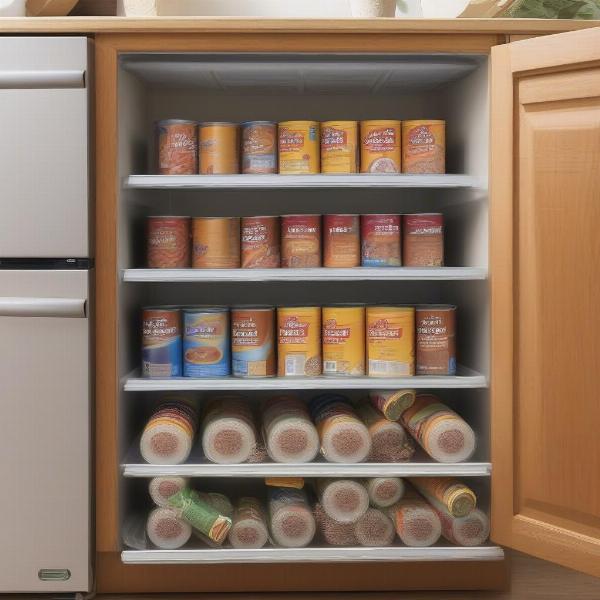Dog food rolls, also known as chubs, are a popular choice for pet owners seeking a convenient and often cost-effective way to feed their furry friends. But are they a healthy and complete option for your dog? This article will delve into the pros and cons of dog food rolls, examining their nutritional value, convenience, and suitability for different breeds and life stages.
Understanding Dog Food Rolls
Dog food rolls typically consist of ground meat and other ingredients, formed into a cylindrical shape and sealed in a convenient, resealable packaging. They offer a moist and palatable alternative to dry kibble, and some dogs, especially picky eaters, may find them more appealing.
Nutritional Value of Dog Food Rolls
The nutritional content of dog food rolls varies significantly depending on the brand and ingredients. High-quality rolls can provide a balanced diet, including essential proteins, fats, vitamins, and minerals. However, some cheaper brands may contain fillers, artificial flavors, and preservatives that offer little nutritional value and can even be harmful to your dog’s health. Always check the ingredient list carefully and look for rolls that list real meat as the primary ingredient.
Are Dog Food Rolls Right for Your Dog?
Whether or not dog food rolls are a good choice for your dog depends on several factors, including their age, breed, activity level, and overall health. Puppies and senior dogs, for instance, have different nutritional needs compared to adult dogs.
Considering Your Dog’s Life Stage
- Puppies: Growing puppies require a diet rich in protein and essential nutrients to support their development. Some dog food rolls are formulated specifically for puppies and can provide the necessary nutrition.
- Adult Dogs: For adult dogs, choose rolls that meet their specific energy requirements based on their breed size and activity level.
- Senior Dogs: Senior dogs may benefit from rolls that are easier to chew and digest, with added joint support supplements.
Potential Drawbacks of Dog Food Rolls
While convenient, dog food rolls can have some drawbacks. They can be messier than kibble and may spoil more quickly once opened. Additionally, some dogs may consume them too rapidly, leading to digestive issues. Portion control is key when feeding your dog rolls.
How to Choose the Best Dog Food Rolls
When choosing dog food rolls, prioritize quality ingredients and look for brands that meet the Association of American Feed Control Officials (AAFCO) standards. Avoid rolls with excessive fillers, artificial colors, and flavors. Consider your dog’s specific dietary needs and consult your veterinarian if you have any concerns.
Storing Dog Food Rolls
Proper storage is crucial to maintain the freshness and quality of dog food rolls. Unopened rolls should be stored in a cool, dry place. Once opened, refrigerate the remaining portion and use it within a few days.  Storing dog food rolls properly
Storing dog food rolls properly
What Are the Benefits of Feeding My Dog Food Rolls?
Some dogs simply prefer the taste and texture of moist food. Rolls can be a good option for picky eaters or dogs with dental issues who have difficulty chewing dry kibble. They also provide hydration, which can be beneficial for dogs who don’t drink enough water.
Conclusion
Dog food rolls can be a convenient and healthy option for your dog if chosen wisely. Prioritize high-quality ingredients, consider your dog’s individual needs, and practice proper storage to ensure your furry friend receives the best possible nutrition. Remember to consult your veterinarian if you have any questions about your dog’s diet.
FAQ
- Are dog food rolls complete and balanced? Some are, but not all. Check the label for the AAFCO statement to ensure it meets your dog’s life stage requirements.
- How long can I store opened dog food rolls? Refrigerate opened rolls and use them within 3-5 days.
- Can puppies eat dog food rolls? Yes, some rolls are formulated specifically for puppies.
- Are dog food rolls good for senior dogs? They can be, especially if they are easy to chew and digest.
- What are the common ingredients in dog food rolls? Common ingredients include meat, meat by-products, grains, vegetables, and vitamins and minerals.
- How much should I feed my dog? Follow the feeding guidelines on the packaging and adjust based on your dog’s individual needs and activity level.
- Can I mix dog food rolls with dry kibble? Yes, many dog owners mix wet and dry food.
Related Articles
dog friendly cottages skye scotland
About ILM Dog
ILM Dog is your trusted resource for expert advice on dog breeds, health, training, nutrition, grooming, and much more. We provide practical tips and recommendations to help you give your canine companion the best possible care. As experts in dog nutrition, we understand the importance of a balanced diet for your dog’s overall health and well-being. For personalized guidance or any questions related to dog care, feel free to contact us via email at [email protected] or phone at +44 20-3965-8624. Visit us at ILM Dog for more information and valuable resources to enhance your dog’s life.